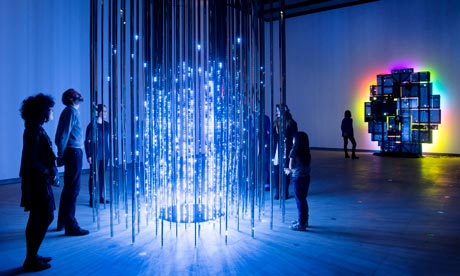-
More short stories I've been enjoying recently.
-
"It’s not always about writing more words or drinking more coffee. Sometimes getting to the end of a novel simply takes remembering that the world is more complicated than we know, and then sticking some of those complications into the story." Applies to lots of things.
-
"This post is a look at the biggest downfalls of distributed startups – specifically the rise of monoculture, siloing of the workforce, isolation of management, expense of communication and loss of group context." Lots of great points, and well-observed counters; useful reading if you only ever work from home occasionally, let alone all the time.
Complexity
04 February 2013

Leo Villarreal’s Cylinder II is the opening work at the Hayward’s Light Show. It’s a very good exhibition, with a few high points; Villarreal’s piece was one of mine.
And yet.
The notes on the piece describes it as featuring “light and movement” composed by “complex computer programming.”
This particular word – complex – frequently annoys me when it comes to technologically manifested art. It annoys me because the craft of the piece is its assembly – both its manufacture, in light and metal, and its programming. But to make a virtue of its complexity… is much like describing Rembrandt as painting in “challenging oil paints”.
It’s one thing to describe the work as complex. But to describe the process the artist took as complex is something else; many artistic processes are complex, but few deserve that complexity highlighting. And in this case… the programming is intricate, and has been executed carefully, but it struck me as just another piece of electronically produced art.
Make no mistake: it’s entirely beautiful. But something about highlighting the complexity of the process when it’s fairly typical of that process rubs up against me; I wonder if it’s the surprise or alienness of technologically manifested work.
Of course, Villarreal’s piece isn’t really about how hard the programming is at all; it’s about how light interacts with a space, how patterns emerge, how we perceive. The programme notes go onto to discuss that, and they do so much better.
It’s a lovely show, though. Not much of it is bad, but the best parts – Villarreal, Eliasson, McCall, Flavin – are wonderful.
(On an entirely separate note: an exhibition in which the ability of the public to read “NO PHOTOGRAPHY” signs was worse than ever. The signs were particularly illegible in the darkened rooms, which rather spoiled my favourite piece of the exhibition – Anthony McCall’s You and I, Horizontal; an exhibit that makes a virtue of carefully shaped light through darkness is somewhat impeded by camera flashes. Leave them at home, folks; it’s art, not a sideshow.)
-
"The walkthrough posted by Lee Beng Hai belongs in a “best games writing” list somewhere, not so much for the prose, but for the depth of his coverage and the gratitude I feel for it, like he’s the first guy in my tribe to wander into the jungle and come back with all his limbs." Chris Dahlen on why nobody's writing about Demon's Souls, but everybody's playing it. (Also: "It’s not “flow”, because flow implies progress; it’s more like tantric sex with a slide rule" is a brilliant analogy).
-
"Clarity is a Splunk like web interface for your server log files. It supports searching (using grep) as well as trailing log files. It has been written using the event based architecture based on EventMachine and so allows real-time search of very large log files. If you hit the browser Stop button it will also kill the grep / tail utility."
-
"a JavaScript GameBoy Emulator" Blimey.
-
"Every family, it seems, has its own set of words for describing particular Lego pieces. No one uses the official names. “Dad, please could you pass me that Brick 2×2?” No. In our house, it’ll always be: “Dad, please could you pass me that four-er?”" So true. I'm trying to recall our own nomenclature.
-
Great interview with Lantz, expanding on his "games aren't media" angle and some other interesting points on aesthetics; totally marred by Michaël Samyn's trolling of a comment thread (on his *own* company's blog). Still, read the top half!
-
"Being NOTES and SLIDES on a talk given at PLAYFUL 09, concerning CHARLES BABBAGE, HEATH ROBINSON, MENACE and MAGE" Awesome; shame I couldn't be there. I wondered where that link about Michie had come from a few weeks ago…